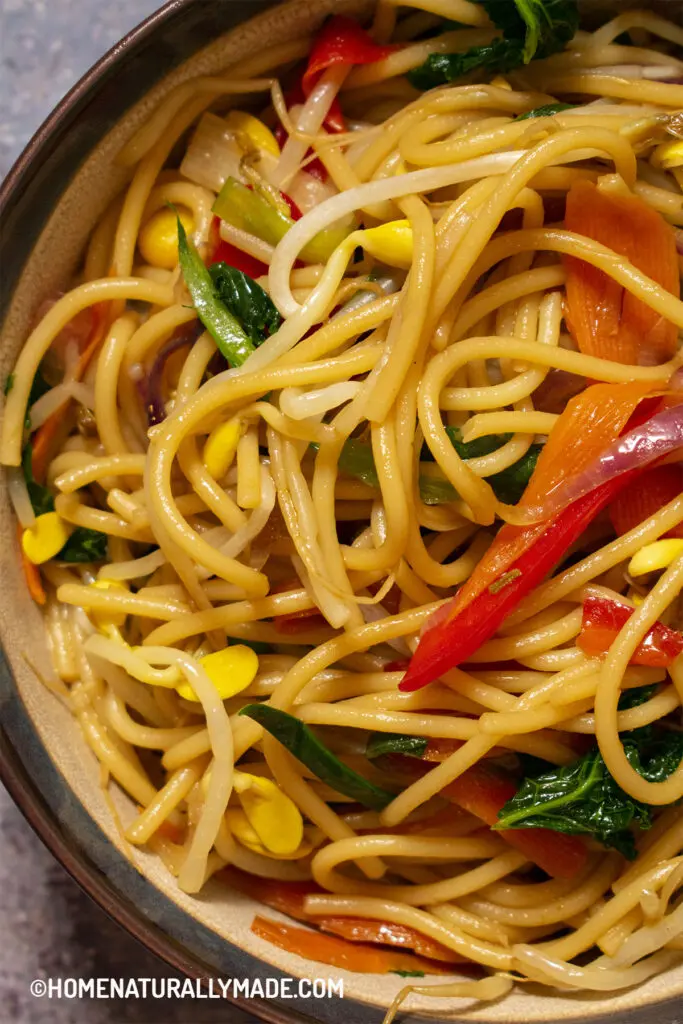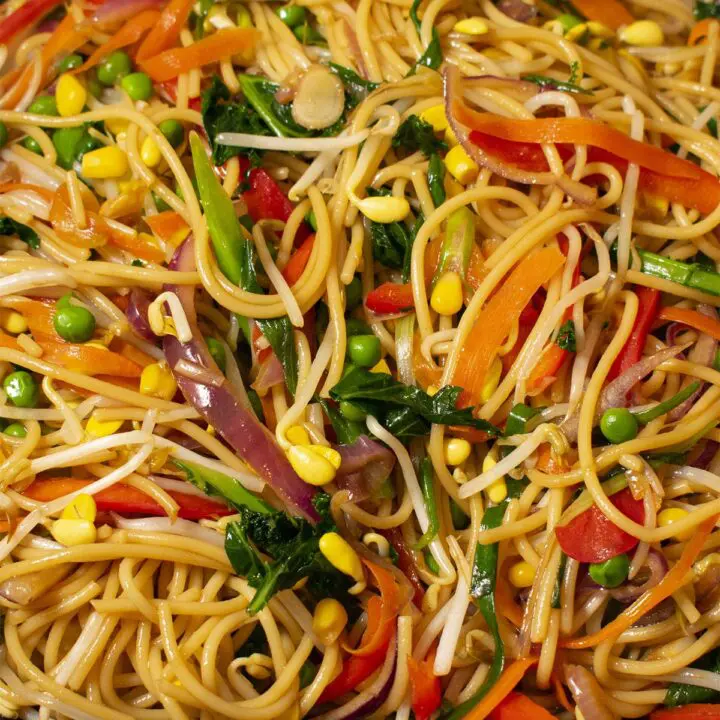Table of Contents
Easy vegan Chow Mein featuring organic spaghetti and an assortment of vegetables such as soybean sprouts, mung bean sprouts, red bell pepper, corn, peas, and kale is so yummy, healthy, and nutritious. Perfect for parties, kids’ school events parent food donations, and/or food prep. This vegan Chow Main is freezer friendly.

What is Chow Mein?
Chow Mein is Cantonese phonetics for Stir-Fried Noodles. “Chow” Or “Chao” {炒} per Roman pinyin systems, which is widely adopted in mainland China, means fry or stir fry. “Mein” or “Mian” {面} means noodles.
Chinese Fried Noodles are a popular one-pot meal. To make Chow Mein, you basically stir fry cooked noodles with vegetables. It is also quite common to add pre-cooked chicken, pork, beef, or shrimp to the mix to complete the meal.

Chow Mein Frequently Asked Questions:
What’s Different between Chow Mein vs. Lo Mein?
The difference is all about whether you stir-fry noodles together with the rest of the ingredients or not.
If you do, then it is Chow Mein. Usually, the noodles are drier and stiffer because of stir-frying. People also use more soy sauce, especially the restaurant version, which makes Chow Mein looks darker.
If you only stir-fry ingredients without noodles first, and then turn off the heat and mix in the cooked noodles, then it is Lo Mein. Therefore, the noodles in Lo Mein are usually in noodles’ original color and are softer. People typically use less soy sauce, thus the color is lighter compared to Chow Mein.
Is Chow Mein Healthy?
It can be, especially when you add a variety of vegetables and do not use excessive soy sauce.

What are my noodle options?
If you have time to make either homemade egg noodles or plain noodles in advance, they are excellent choices.
You can also choose from a wide variety of store-bought dry noodles including egg noodles or Yang Chun noodles. These days I also become a fan of this organic spaghetti, when cooked right, they are wonderful for making Chinese Fried Noodles or Noodle Salad.

How to cook noodles for a firm bite and spongy texture?
One important thing to keep in mind is that the optimally cooked noodles for Chow Mein need to be moist but have a spongy texture so they can better handle the stir-fry process without getting either dried out or mushy.
The key to moist while spongy noodles are to boil a big pot of water for making a relatively small amount of noodles. The less time used to cook the noodle, the better the noodle tastes. Check out how to cook dry pasta or noodles for more details.

How to pick an optimally balanced vegetable assortment?
We need two types of vegetables: flavoring herbs and additional complementary vegetables.

Flavoring herbs is to provide a unique aroma and taste to the noodles. Green onion, red onion, leek, garlic leaves, and celery are among the choices.
Complementary vegetables are to supplement the texture or color of the food or provide additional vegetables for a healthy meal.
Mung bean sprouts are among my most recommended must-have item. They look like noodles and can easily blend in. Meanwhile, they help separate noodles from sticking to each other and add a hint of crunchy texture. corn and peas are optional, but they contribute to the additional texture.

Green leafy vegetables such as kale or bok choy are wonderful choices.
Something that contributes to the color appeal is also important. Carrot slices and/or red bell pepper serve just like that.

I do not have a vegetable assortment, can I still make a tasty Chow Mein?
No problem. It works as long as you have either green onions, red onions, leeks, or celery. Just remember to adjust the oil and soy sauce level accordingly if you do not plan to use lots of vegetables.
How much oil and soy sauce should I use to make a healthy & tasty Chow Mein?
The rule of thumb is for every pound of noodle/vegetable combo, use one tablespoon of cooking oil. I usually use 2/3 avocado oil and 1/3 sesame oil combo. As for the soy sauce, use the same amount as cooking oil. I usually use 2/3 light soy sauce and 1/3 dark soy sauce combo for a balanced flavor and color.
Last but not least is to add a tiny bit of cane sugar to make the flavor pop. Only need 1/4 tsp for every 3 pounds of noodle/vegetable combo.
Do you like healthy tasty “Better Than Takeouts”? Make sure you check out below:

Easy Yummy Vegan Chow Mein Recipe
Easy vegan chow mein featuring organic spaghetti and an assortment of vegetables such as soybean sprouts, mung bean sprouts, red bell pepper, corn, peas, and kale is so yummy, healthy, and nutritious. Perfect for parties and/or food prep. This vegan Chow Main is freezer friendly.
Ingredients
- 1 pack of dried organic spaghetti, 500 g, see notes
- 4 tbsp avocado oil or other types of cooking oil
- 2 tbsp sesame oil
- 4 tbsp light soy sauce
- 2 tbsp naturally aged soy sauce or dark soy sauce
- 1/2 tsp cane sugar
- 3 stalks green onion, thinly sliced
- 2.5 lb - 3 lb of vegetable assortment, choose from the below list: mung bean sprouts (0.5 lb), soybean sprouts (0.5 lb), green leafy such as bok choy, kale, leek, cut into thin long strips, mushroom, celery, carrots, red onion, frozen peas (1 cup) and/or corns (1 cup)
- 1/2 tsp salt, such as Himalayan pink salt to stir fry the 3 lb vegetable assortment
Instructions
Prep Ingredients:
- Gather ingredients. Add 4 tbsp avocado oil and 2 tbsp sesame oil in a small bowl. Add 4 tbsp light soy sauce and 2 tbsp naturally aged soy sauce (dark soy sauce) in another small bowl.

- Dried organic spaghetti works very well for Chow Mein. They usually come in a package of 500 g. I usually cook 1 pack at a time and use it for the week.
- To cook the dried spaghetti, fill a large stockpot (8-Q minimum) with water, cover the lid and bring it to a boil, about 18 minutes. Once it reaches a boil, carefully add the dried spaghetti, separate them and turn the heat to simmer, cover the lid and cook for 10 minutes. Then immediately remove the spaghetti from the pot with the assistance of a stainless spider and cooking chopsticks. This will give the past a firm bite texture which ensures a tasty noodle dish. Read here for how to cook dry pasta for tasty noodles in more detail.

- Blanch the soybean sprouts, frozen peas, and frozen corn if you use them. You can use the same water boiling the spaghetti to blanch the vegetables. Bring the pot to a boil again and then add the vegetables. Cook for 3 minutes or till reaches a boil again and then remove using a strainer or skimmer, and then set aside.

- Cut onions into slices, peel the carrots into thin layers using a peeler, and cut the green leafy vegetable and red bell pepper into long thin strips.
Stir-Fry Noodles with Vegetables:
- Turn the heat to medium-high and heat the cast iron wok for 1 minute.
- Pour some avocado oil and sesame oil from the small bowl into the wok, along with the green onion, carrots, kale, and red bell pepper, along with 1/2 tsp Himalayan pink salt. Toss and fold using a pair of bamboo spatulas for about 2-3 minutes, or till the vegetables start to wilt.

- Add the cooked spaghetti into the wok, and pour the rest of the avocado oil/sesame oil combo on top of the noodles in a circular motion.

- Toss and fold the noodles with the vegetables in the wok using a pair of bamboo spatulas, the same way as tossing a salad, about 1.5 minutes, or till the noodles are mixed with the vegetables nicely.

- Add mung bean sprouts and blanched vegetables such as soybean sprouts, corn, and peas, and pour the naturally aged soy sauce and light soy sauce combo in a circular motion on top of the noodles and vegetables, along with the 1/2 tsp cane sugar.

- Continue to toss and fold using the pair of bamboo spatulas for about 1.5 minutes, or till everything is mixed well.

- All done! Enjoy an easy, tasty, and healthy Chow Mein.

Notes
- A pack of 500 g of organic spaghetti produces about 1190 g (~2.6 lb) of cooked noodles.
- This recipe uses an assortment of vegetables. It is OK if you do not have all of the vegetable choices. Green onion, however, is highly recommended. If you do not use close to 3 lb of vegetables, then consider cutting down the salt, oil, and soy sauce accordingly.
- The rule of thumb - for every pound of noodle/vegetable combo, use one tablespoon of cooking oil. I usually use 2/3 avocado oil and 1/3 sesame oil combo for the best flavor. As for the soy sauce, use the same amount as cooking oil. I usually use 2/3 light soy sauce and 1/3 dark soy sauce combo for a balanced flavor and color.
- This recipe is perfect for parties and/or food preparation for lunch. This vegan chow mein is freezable.
- Homemade egg noodles or homemade noodles are an excellent choice for Chow Mein.
Recommended Products
As an Amazon Associate, I earn a small amount of commission from the qualifying purchases.
-
 extra long cooking chop sticks
extra long cooking chop sticks -
 Solid Stainless Steel Spider Strainer Skimmer
Solid Stainless Steel Spider Strainer Skimmer -
 Viking 3-Ply Stainless Steel Stock Pot, 12 Quart
Viking 3-Ply Stainless Steel Stock Pot, 12 Quart -
 Organic Cane Sugar
Organic Cane Sugar -
 Light Soy Sauce
Light Soy Sauce -
 Dark Soy Sauce
Dark Soy Sauce -
 Wan Ja Shan Naturally Brewed Soy Sauce (2 Pack, Total of 33.8fl.oz)
Wan Ja Shan Naturally Brewed Soy Sauce (2 Pack, Total of 33.8fl.oz) -
 ORGANIC Spaghetti
ORGANIC Spaghetti -
 Avocado Oil
Avocado Oil -
 Kadoya Sesame Oil, 22.10 Fl Oz
Kadoya Sesame Oil, 22.10 Fl Oz -
 Bamboo Spoons & Spatula
Bamboo Spoons & Spatula -
 KitchenAid Classic Slotted Turner, One Size, Black
KitchenAid Classic Slotted Turner, One Size, Black -
 Cast Iron Wok with Flat Base 14 inch
Cast Iron Wok with Flat Base 14 inch
Nutrition Information
Yield 8 Serving Size 1Amount Per Serving Calories 523Total Fat 17gSaturated Fat 3gTrans Fat 0gUnsaturated Fat 13gCholesterol 12mgSodium 1292mgCarbohydrates 74gFiber 18gSugar 15gProtein 20g
Nutrition calculation is provided by Nutritionix to the best knowledge per ingredients description and isn't always accurate.
